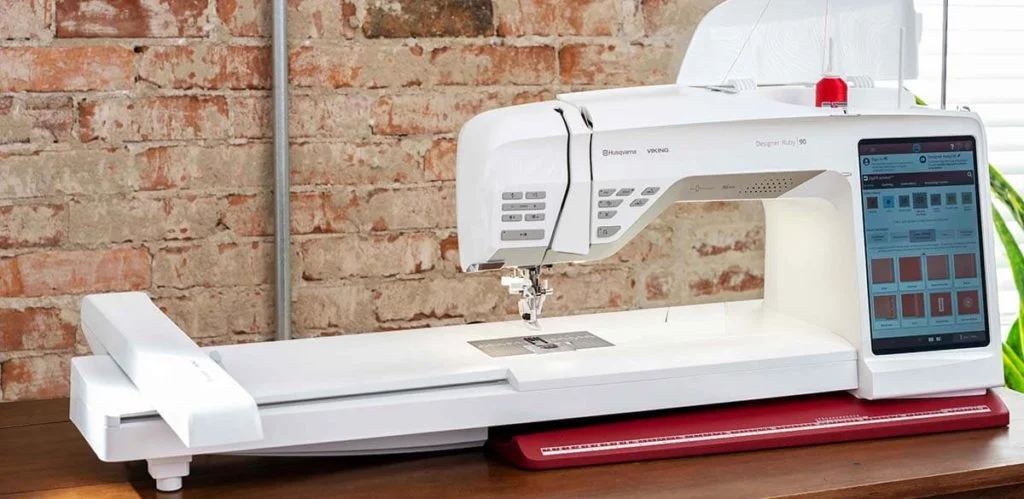Viking Husqvarna Sewing Machine Repair

Sewing machines are very important tools. When something goes wrong with your machine, you should repair it. Older sewing machines can last for a long time if properly maintained. Computerized sewing machines can last for up to 25 years. Basic maintenance will help you avoid expensive repairs.
Is It Worth Repairing a Sewing Machine?
Repairing your sewing machine if it’s a Viking Husqvarna is almost always a good idea if it’s of high quality. You can learn to make any repairs, and even going to a professional will cost you much less than purchasing a new sewing machine!
Additionally, given proper care, older sewing machines may last for many years. Depending on the quality of construction, new, computerized machines can endure anywhere from five to twenty-five years.
Of course, learning how to perform basic maintenance on your machine will help you avoid a lot of costly repairs in the future. Taking your automobile in for an oil change or tire rotation, for example, will help it run much longer!
The vast majority of the time, minor problems like a bent needle, tangled tension, loose stitching, or blocked bobbin may be easily resolved.
If you experience a touchscreen not responding, it’s possible that professional assistance is required. Whether you’re comfortable dismantling components inside the machine or not,
So, how much do you need to know in order to become a DIY sewing machine specialist? Not much! It’s handy to have an idea of what goes on inside a sewing machine.
You’ll also want to have your sewing machine’s user guide on hand, because it will contain useful information about many basic maintenance and cleaning procedures. Husqvarna Viking sowing machines have a wide range of tutorials accessible for free on YouTube. There’s also a helpful visual guide for many fundamental repairs in these videos. Finally, this post will show you how to perform the most common repairs on your Husqvarna Viking machine yourself.
Sewing machines are quite useful. The majority of users appreciate their use. However, there are certain aspects of sewing machines that make them challenging to work with. When you sew two pieces together, for example, it is critical not to slice yourself. You also need to pay attention to what you’re doing. And if you try to do too many things at once, you could get confused. You will need to have a manual available when you begin to repair your sewing machine. YouTube videos can provide a great visual reference for several basic repairs. This article will show you how to do some of the most frequent repairs with your sewing machine.
Viking Sewing Machine Repair
If you’re considering repairing your Viking sewing machine then you’ll want to know what common errors you might encounter. If you need to replace any part of the system, you may also need to know which parts to buy. You will need to know when enough is enough. When you’ve tried everything and nothing works, it’s time to call a technician.
Husqvarna Viking Sewing Machine Troubleshooting
To fix your Husqvarna Viking most effectively, you need to know how to clean it properly, how to thread it, whether or not to use oil, and what your warranties cover.
First, here’s a quick summary of what to expect from the Viking model.
Husqvarna Viking, which was founded in 1891, has a long history as a manufacturing company located in Sweden. Husqvarna began making sewing machines in the late 19th century, and the company still design their new models in Sweden today
The brand has a sterling reputation for delivering reliable, state-of-the-art sewing technology.
That being said, Viking was purchased by SVP Worldwide in the 2000s. Since then, the manufacture of the machines has been done in China.
Before 1900, Viking models were considered antiques and could be valuable collector’s items. Vintage models made between 1900 and 1970 are usually called “vintage.” They are valuable because they contain solid metal components and can run for decades.
As you begin troubleshooting your machine, start by figuring out what year it was manufactured. This will help you figure out what kind of things you might be able to fix yourself.
All sewing machines, whether fancy or cheap, require cleaning. Unless you haven’t maintained your machine for some time, you can usually perform these maintenance tasks every month to keep everything in top shape.
You don’t want to be cleaning out the lint trap every time you do laundry, so get rid of it. Sewing machines collect a buildup of fibers from the fabric they’re working on. Cleaning out the lint around your bobbin casing and thread paths will prevent your sewing machine from getting clogged over time.
You should also remove the needle plate and clean out any lint from inside the barrel. You shouldn’t need this detailed more than once per month unless you sew all the time, every day!
Older machines may need a few drops of sewing-machine oil in key places regularly to keep them running smoothly. As a general rule, most new machines should not be oiled. Check your manual to see if you need oil or not.
Modern machines usually have a plastic casing that can be wiped down with a soft cloth, so you don’t need to worry about cleaning them yourself. You should never use a wet cloth on metal or cast-iron machines, as this could cause rusting.
When starting a new project, always take care to choose the right needle for the job. If you feel like it’s too much, at the very least, clean the needle before using it again.
Finally, do a quick test run on a scrap piece of fabric to make sure it works.
